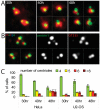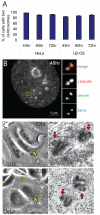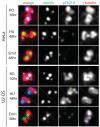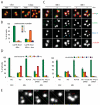Centriole reduplication during prolonged interphase requires procentriole maturation governed by Plk1
- PMID: 20656208
- PMCID: PMC2911792
- DOI: 10.1016/j.cub.2010.05.050
Centriole reduplication during prolonged interphase requires procentriole maturation governed by Plk1
Abstract
Supernumerary centrioles lead to abnormal mitosis, which in turn promotes tumorigenesis. Thus, centriole duplication must be coordinated with the cell cycle to ensure that the number of centrioles in the cell doubles precisely during each cell cycle. However, in some transformed cells, centrioles undergo multiple rounds of duplication (reduplication) during prolonged interphase. Mechanisms responsible for centriole reduplication are poorly understood. Here, we report that centrioles reduplicate consistently in cancerous and nontransformed human cells during G2 arrests and that this reduplication requires the activity of Polo-like kinase 1 (Plk1). We also find that a cell's ability to reduplicate centrioles during S arrests depends on the presence of activated (Thr210-phosphorylated) Plk1 at the centrosome. In the absence of activated Plk1, nascent procentrioles remain associated with mother centrioles, which prevents centriole reduplication. In contrast, if Plk1(pT210) appears at the centrosome, procentrioles mature, disengage from mother centrioles, and ultimately duplicate. Plk1 activity is not required for the assembly of procentrioles, however. Thus, the role of Plk1 is to coordinate the centriole duplication cycle with the cell cycle. Activation of Plk1 during late S/G2 induces procentriole maturation, and after this point, the centriole cycle can be completed autonomously, even in the absence of cell-cycle progression.
2010 Elsevier Ltd. All rights reserved.
Figures




Similar articles
-
Plk1 relieves centriole block to reduplication by promoting daughter centriole maturation.Nat Commun. 2015 Aug 21;6:8077. doi: 10.1038/ncomms9077. Nat Commun. 2015. PMID: 26293378 Free PMC article.
-
Cep57 and Cep57L1 maintain centriole engagement in interphase to ensure centriole duplication cycle.J Cell Biol. 2021 Mar 1;220(3):e202005153. doi: 10.1083/jcb.202005153. J Cell Biol. 2021. PMID: 33492359 Free PMC article.
-
Stable centrosomal roots disentangle to allow interphase centriole independence.PLoS Biol. 2018 Apr 12;16(4):e2003998. doi: 10.1371/journal.pbio.2003998. eCollection 2018 Apr. PLoS Biol. 2018. Update in: PLoS Biol. 2022 Oct 25;20(10):e3001854. doi: 10.1371/journal.pbio.3001854. PMID: 29649211 Free PMC article. Updated.
-
Role of Polo-like Kinases Plk1 and Plk4 in the Initiation of Centriole Duplication-Impact on Cancer.Cells. 2022 Feb 24;11(5):786. doi: 10.3390/cells11050786. Cells. 2022. PMID: 35269408 Free PMC article. Review.
-
Show me your license, please: deregulation of centriole duplication mechanisms that promote amplification.Cell Mol Life Sci. 2013 Mar;70(6):1021-34. doi: 10.1007/s00018-012-1102-6. Epub 2012 Aug 15. Cell Mol Life Sci. 2013. PMID: 22892665 Free PMC article. Review.
Cited by
-
Identification of cilia genes that affect cell-cycle progression using whole-genome transcriptome analysis in Chlamydomonas reinhardtti.G3 (Bethesda). 2013 Jun 21;3(6):979-91. doi: 10.1534/g3.113.006338. G3 (Bethesda). 2013. PMID: 23604077 Free PMC article.
-
Clinically Applicable Inhibitors Impacting Genome Stability.Molecules. 2018 May 13;23(5):1166. doi: 10.3390/molecules23051166. Molecules. 2018. PMID: 29757235 Free PMC article. Review.
-
Precocious centriole disengagement and centrosome fragmentation induced by mitotic delay.Nat Commun. 2017 Jun 13;8:15803. doi: 10.1038/ncomms15803. Nat Commun. 2017. PMID: 28607478 Free PMC article.
-
Opposing post-translational modifications regulate Cep76 function to suppress centriole amplification.Oncogene. 2016 Oct 13;35(41):5377-5387. doi: 10.1038/onc.2016.74. Epub 2016 Apr 11. Oncogene. 2016. PMID: 27065328 Free PMC article.
-
Regulation of centriolar satellite integrity and its physiology.Cell Mol Life Sci. 2017 Jan;74(2):213-229. doi: 10.1007/s00018-016-2315-x. Epub 2016 Aug 2. Cell Mol Life Sci. 2017. PMID: 27484406 Free PMC article. Review.
References
Publication types
MeSH terms
Substances
Grants and funding
LinkOut - more resources
Full Text Sources
Molecular Biology Databases
Miscellaneous

